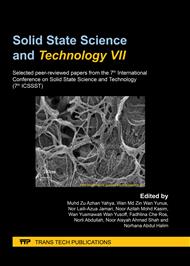[1]
M.A. Azmi, S.M. Yahya, S. Ahmad, S. Mahzan, M. Taib, H.A. Rahman, H. Taib, Effect of silica (SiO2) filler on thermal stability of polysiloxane composites, J. Adv. Res. Fluid Mech. Therm. Sci. 48(2) (2018) 117–124.
Google Scholar
[2]
M.A. Azmi, S. Mahzan, S. Ahmad, S.M. Salleh, H.A. Rahman, M.A. Choiron, A. Ismail, H. Taib, Vibration exposure of polydimethylsiloxane (PDMS) reinforced silica (SiO2): Comparison of different source of silica (SiO2) as filler, IOP Conf. Ser.: Mater. Sci. Eng. 494 (2019).
DOI: 10.1088/1757-899x/494/1/012069
Google Scholar
[3]
S.M. Yahya, A. Azmi, S. Ahmad, H. Taib, Characterisation of hand-cast polysiloxane-silica sheet composite, Adv. Mater. Res. 893 (2014) 250-253.
DOI: 10.4028/www.scientific.net/amr.893.250
Google Scholar
[4]
S.M. Yahya, A. Azmi, M.I. Idris, M.Z. Yunos, S. Mahzan, S. Ahmad, H Taib, Short review: Role of metal oxides as filler in polysiloxane sheet composite, Appl. Mech. Mater. 465–466 (2014) 27-31.
DOI: 10.4028/www.scientific.net/amm.465-466.27
Google Scholar
[5]
N. Mustaffa, M. Fawzi, S.A. Osman, M.M. Tukiman, Experimental analysis of liquid LPG injection on the combustion, performance and emissions in a spark ignition engine, IOP Conf. Ser.: Mater. Sci. Eng. 469(1) (2019) 12033.
DOI: 10.1088/1757-899x/469/1/012033
Google Scholar
[6]
N.A. Nazaruddin, P.S. Abdul Rahim, M. Rizamarhaiza, W.M. Hasif A.A.K, M. Azham Azmi, H. Taib, S. Ahmad, The Effect of Different Binder Compositions in Fabricating Silica Foam (SiO2) Via Replication Method, J. Mech. Eng. 14 (2017) 53-62.
Google Scholar
[7]
N.A.A. Ismail, M. Azham Azmi, S. Ahmad, H. Taib, Effect of Rice Husk Firing Temperature on Synthesis of Silica (SiO2), Adv. Mater. Res. 1087 (2014) 470–474.
DOI: 10.4028/www.scientific.net/amr.1087.470
Google Scholar
[8]
S. Mahzan, M.A. Azmi, H. Taib, N.E.N.A. Mohammad, Vibration Exposure Analysis of the Polysiloxane Reinforced with Rice Husk Silica, Appl. Mech. Mater. 660 (2014) 531–535.
DOI: 10.4028/www.scientific.net/amm.660.531
Google Scholar
[9]
M.A. Azmi, M.S.M. Marsayid, S. Mahzan, S. Ahmad, H. Taib, Vibration exposure analysis of polydimethylsiloxane reinforced silica derived rice husk ash, Malaysian J. Anal. Sci. 20(5) (2016) 1138–1144.
DOI: 10.17576/mjas-2016-2005-20
Google Scholar
[10]
M.F. Sies, N.F. Madzlan, N. Asmuin, A. Sadikin, H. Zakaria, Determine spray droplets on water sensitive paper (WSP) for low pressure deflector nozzle using image J, IOP Conf. Ser.: Mater. Sci. Eng. 243(1) (2017) 12047.
DOI: 10.1088/1757-899x/243/1/012047
Google Scholar
[11]
M.A. Azmi, N.A.A. Ismail, M. Rizamarhaiza, W.M. Hasif A.A.K., H. Taib, Characterisation of silica derived from rice husk (Muar, Johor, Malaysia) decomposition at different temperatures, AIP Conf. Proc. 1756 (2016).
DOI: 10.1063/1.4958748
Google Scholar
[12]
K. Kamarudin, M.S. Wahab, Z. Shayfull, A. Ahmed, A.A. Raus, Dimensional accuracy and surface roughness analysis for AlSi10Mg produced by selective laser melting (SLM), MATEC Web Conf. 78 (2016) 1077.
DOI: 10.1051/matecconf/20167801077
Google Scholar
[13]
I.J. Fernandes, D. Calheiro, A.G. Kieling, C.A.M. Moraes, T.L.A.C. Rocha, F.A. Brehm, R.C.E. Modolo, Characterization of rice husk ash produced using different biomass combustion techniques for energy, Fuel 165 (2016) 351–359.
DOI: 10.1016/j.fuel.2015.10.086
Google Scholar
[14]
N. Van Tuan, G. Ye, K. van Breugel, A.L.A. Fraaij, D.D. Bui, The study of using rice husk ash to produce ultra high performance concrete, Constr. Build. Mater. 25(4) (2011) 2030–(2035).
DOI: 10.1016/j.conbuildmat.2010.11.046
Google Scholar
[15]
I.J. Fernandes, F.A.L. Sánchez, J.R. Jurado, A.G. Kieling, T.L.A.C. Rocha, C.A.M. Moraes, V.C. Sousa, Physical, chemical and electric characterization of thermally treated rice husk ash and its potential application as ceramic raw material, Adv. Powder Technol. 28(4) (2017) 1228-1236.
DOI: 10.1016/j.apt.2017.02.009
Google Scholar
[16]
N. Yalçin, V. Sevinç, Studies on silica obtained from rice husk, Ceram. Int. 27(2) (2001) 219–224.
DOI: 10.1016/s0272-8842(00)00068-7
Google Scholar
[17]
S. Ansorge, K. Papailiou, Mechanical properties of silicone rubber under high loadings of alumina trihydrate filler, J. Elastomers Plast. 48(4) (2016) 354-382.
DOI: 10.1177/0095244315580452
Google Scholar
[18]
S. Prasertsri, N. Rattanasom, Fumed and precipitated silica reinforced natural rubber composites prepared from latex system: Mechanical and dynamic properties, Polym. Test. 31(5) (2012) 593-605.
DOI: 10.1016/j.polymertesting.2012.03.003
Google Scholar
[19]
M.N. Roslan, M.Y. Yahya, Z. Ahmad, A.R. Azrin Hani, Energy absorption behaviour of braided basalt composite tube, Adv. Compos. Mater. 27(5) (2018) 467-481.
DOI: 10.1080/09243046.2017.1405604
Google Scholar
[20]
S. Hassan, M.S. Yusof, Z. Embong, Angle resolve x-ray photoelectron spectroscopy analysis of La2O3 thin film of mixed carbon-glass and carbon-silicon substrate for micro-flexographic printing process, IOP Conf. Ser.: Mater. Sci. Eng. 555(1) (2019) 12027.
DOI: 10.1088/1757-899x/555/1/012027
Google Scholar
[21]
S.M. Zayed, A.M. Alshimy, A.E. Fahmy, Effect of surface treated silicon dioxide nanoparticles on some mechanical properties of maxillofacial silicone elastomer, Int. J. Biomater. 2014 (2014).
DOI: 10.1155/2014/750398
Google Scholar
[22]
M.H.I. Ibrahim, M.H.A. Manaff, M.H. Othman, N. Mustafa, S.R. Masrol, N.H. Rafai, Optimisation of processing condition using taguchi method on warpage for HDPE-clay composite, Appl. Mech. Mater. 660 (2014) 28-32.
DOI: 10.4028/www.scientific.net/amm.660.28
Google Scholar


